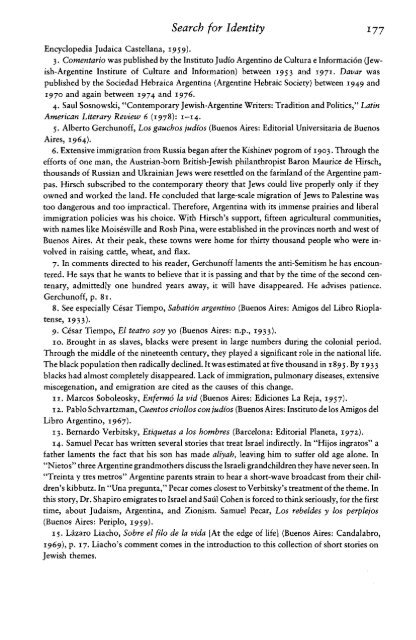Introduction - American Jewish Archives
Introduction - American Jewish Archives
Introduction - American Jewish Archives
Create successful ePaper yourself
Turn your PDF publications into a flip-book with our unique Google optimized e-Paper software.
Search for Identity 177<br />
Encyclopedia Judaica Castellana, 1959).<br />
3. Comentario was published by the Instituto Judio Argentino de Cultura e Informaci6n (Jew-<br />
ish-Argentine Institute of Culture and Information) between 1953 and 1971. Davar was<br />
published by the Sociedad Hebraica Argentina (Argentine Hebraic Society) between 1949 and<br />
1970 and again between 1974 and 1976.<br />
4. Saul Sosnowski, "Contemporary <strong>Jewish</strong>-Argentine Writers: Tradition and Politics," Latin<br />
<strong>American</strong> Literary Review 6 (1978): 1-14.<br />
5. Alberto Gerchunoff, Los gauchos judios (Buenos Aires: Editorial Universitaria de Buenos<br />
Aires, 1964).<br />
6. Extensive immigration from Russia began after the Kishinev pogrom of 1903. Through the<br />
efforts of one man, the Austrian-born British-<strong>Jewish</strong> philanthropist Baron Maurice de Hirsch,<br />
thousands of Russian and Ukrainian Jews were resettled on the farimland of the Argentine pam-<br />
pas. Hirsch subscribed to the contemporary theory that Jews could live properly only if they<br />
owned and worked the land. He concluded that large-scale migration of Jews to Palestine was<br />
too dangerous and too impractical. Therefore, Argentina with its immense prairies and liberal<br />
immigration policies was his choice. With Hirsch's support, fifteen agricultural communities,<br />
with names like Moisesville and Rosh Pina, were established in the provinces north and west of<br />
Buenos Aires. At their peak, these towns were home for thirty thousand people who were in-<br />
volved in raising cattle, wheat, and flax.<br />
7. In comments directed to his reader, Gerchunoff laments the anti-Semitism he has encoun-<br />
tered. He says that he wants to believe that it is passing and that by the time of the second cen-<br />
tenary, admittedly one hundred years away, it will have disappeared. He advises patience.<br />
Gerchunoff, p. 81.<br />
8. See especially CCsar Tiempo, Sabation argentino (Buenos Aires: Amigos del Libro Riopla-<br />
tense, 1933).<br />
9. Cesar Tiempo, El teatro soy yo (Buenos Aires: n.p., 1933).<br />
10. Brought in as slaves, blacks were present in large numbers during the colonial period.<br />
Through the middle of the nineteenth century, they played a significant role in the national life.<br />
The black population then radically declined. It was estimated at five thousand in 1895. By 1933<br />
blacks had almost completely disappeared. Lack of immigration, pulmonary diseases, extensive<br />
miscegenation, and emigration are cited as the causes of this change.<br />
11. Marcos Soboleosky, Enfermo la vid (Buenos Aires: Ediciones La Reja, 1957).<br />
I 2. Pablo Schvartzrnan, Cuentos criollos con judios (Buenos Aires: Instituto de 10s Amigos del<br />
Libro Argentino, 1967).<br />
13. Bernardo Verbitsky, Etiquetas a 10s hombres (Barcelona: Editorial Planeta, 1972).<br />
14. Samuel Pecar has written several stories that treat Israel indirectly. In "Hijos ingratos" a<br />
father laments the fact that his son has made aliyah, leaving him to suffer old age alone. In<br />
"Nietos" three Argentine grandmothers discuss the Israeli grandchildren they have never seen. In<br />
"Treinta y tres metros" Argentine parents strain to hear a short-wave broadcast from their chil-<br />
dren's kibbutz. In "Una pregunta," Pecar comes closest to Verbitsky's treatment of the theme. In<br />
this story, Dr. Shapiro emigrates to Israel and Saul Cohen is forced to think seriously, for the first<br />
time, about Judaism, Argentina, and Zionism. Samuel Pecar, Los rebeldes y 10s perplejos<br />
(Buenos Aires: Periplo, 1959).<br />
15. Lizaro Liacho, Sobre el filo de la vida [At the edge of life] (Buenos Aires: Candalabro,<br />
1969), p. 17. Liacho's comment comes in the introduction to this collection of short stories on<br />
<strong>Jewish</strong> themes.

















